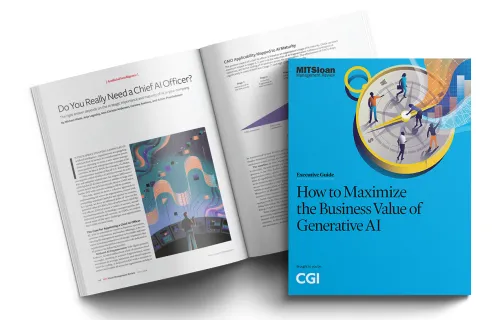Artificial Intelligence (AI) is all the buzz right now; from watercoolers to boardrooms, the topic is on everyone's minds. Advocates tout incredible productivity gains and cost savings that can be achieved with AI. On the flip side, AI risks are also being reported. Headlines warn of huge server costs, intellectual property lawsuits, and embarrassing faux pas brought on by poorly planned, hastily deployed, or under-tested AI deployments.
The reality is that even with those risks, the adoption of AI is increasing. In the most recent CGI Voice of Our Clients survey, nearly two-thirds of agile organizations have accelerated their AI implementation. Organizations that take a wait-and-see approach risk losing the first-mover advantage and seeing competitors reap the benefits promised by the AI revolution. How can insurance organizations balance the costs and benefits of AI adoption?
Costs of AI in insurance
Insurers must consider the direct "hard costs" and indirect "soft costs" involved when evaluating AI.
Hard costs
A hard cost is a new activity that has a quantifiable expense directly associated with it. These hard costs are tangible and can be accurately calculated, making them essential when budgeting for an AI initiative. Examples of hard costs include:
- Training costs - AI models must be trained in a company's specific data and processes, just like onboarding a new employee. While expensive, proper training allows the model to provide maximum value tailored to the insurer's business.
- Staffing costs - AI experts with niche skills are in high demand and short supply, commanding premium salaries. Turnover can also be high as skilled staff pursue better opportunities. However, experienced AI staff can ensure models avoid common pitfalls and achieve faster productivity.
- Runtime costs - Some AI models, like large language models, require immense computing power, creating high operating costs per use. Other models may have lower runtime expenses but higher training overhead. Choosing the right model balances these tradeoffs.
Soft costs
A soft cost is an indirect cost of deploying a model. While hard costs are direct and quantifiable, soft costs can be more significant and challenging to quantify. Soft costs tend to be unexpected and typically represent negative impacts or opportunity costs that may not be immediately apparent. Examples of soft costs include:
- Opportunity costs - Failing to adopt AI could give competitors a potential speed, efficiency, and profitability edge to undercut pricing or poach customers.
- Reputational costs—Poorly deployed AI can lead to harmful errors, such as wrongly denying healthcare coverage. This regulatory scrutiny, lawsuits, and brand damage result in both financial costs and increased staffing needs.
- Competition costs - AI allows competitors to reduce costs through automation, customize pricing for more competitive rates, and provide better customer service - potentially stealing market share.
Other key considerations of AI in insurance
AI Regulations
While no federal AI laws exist yet for insurance, some states have started enacting their own rules. The National Association of Insurance Commissioners (NAIC) has published AI principles that insurers should follow. At the individual state level, they are starting to develop regulations around the use of AI in insurance that need to be considered and adhered to within the rate-making and deployment process. Existing federal laws and regulations like the Fair Credit Reporting Act (FCRA) and Gramm-Leach-Bliley Act (GLB Act), the McCarran-Ferguson Act, and the NAIC Unfair Trade Practices Act, as well as a variety of state-level laws and regulations like the California Consumer Privacy Act (CCPA) and the Colorado Privacy Act also impact AI usage.
Outside the U.S., AI regulation seeks to balance concerns about innovation with concerns about individual privacy and accountability. The EU AI Act provides a rules framework that applies to all industries, including insurance and seeks to apply risk-adjusted regulation to the AI technology space.
Ethical AI
Beyond just compliance, insurers must ensure their AI models are transparent, unbiased, and ethical - especially when used for critical functions like claims decisioning that impact people's lives. Governance processes are essential.
The benefits of AI in insurance
Despite the costs and potential risks, AI offers insurers significant advantages across virtually all business functions when implemented effectively. Companies that effectively incorporate AI into their business stand to gain processing efficiencies, competitive advantages, and improve customer service.
Claims processing
AI capabilities like text recognition and sentiment analysis can drastically improve claims workflows through automation. There are several commercial products on the market, as well as in-house capabilities that companies have developed over time.
Rating and underwriting
In rate-making, AI enables advanced pricing models that can granularly segment and quantify risk at the individual policyholder level, allowing more personalized and actuarially precise premiums. Ratabase360 allows insurers to incorporate the results of AI models into premium calculations. Ratabase Actuarial extends this capability, allowing insurers to use AI model results in rate-making and experimentation.
For underwriting, AI surfaces relevant data insights upfront, streamlining workflow by minimizing low-value manual reviews so underwriters can focus on high-stakes cases requiring human expertise. Across both functions, AI enhances pricing sophistication, decision accuracy, and productivity.
Fraud prevention and detection
AI also unlocks significant value in the underwriting process through advanced fraud detection and intelligent data triaging capabilities. AI models can automatically surface high-risk cases requiring underwriter review by analyzing submissions for anomalous data points and aggregating pertinent information from internal and external sources. This allows underwriting teams to optimize their time by focusing only on the submissions and risks that demand professional expertise and judgment. In the claims process, AI can help identify potentially fraudulent claims on an individual basis by examining claims in the aggregate to identify patterns of activity that could indicate fraud.
Three paths to AI adoption
With the costs, benefits, and risks understood, insurers can pursue three main approaches for AI adoption:
1. Build your own model
Building proprietary AI models involves developing exclusive solutions tailored to an organization's unique needs and requirements. It offers the highest degree of customization, potential competitive differentiation, and the ability to generate valuable intellectual property. However, this bespoke approach comes with substantial upfront costs, resource demands, and the need for significant in-house AI expertise across data science, engineering, and product development. It makes sense primarily when no viable off-the-shelf AI solution meets an insurer's needs.
2. Buy and integrate a model
The most prevalent path for AI adoption currently is buying pre-built platforms and toolkits from vendors; an example CGI offers is CGI PulseAI. Insurers purchase these packaged AI solutions, then adapt and integrate them with their systems and data for specific use cases. This approach enables maintaining data residency and full auditability to meet regulatory requirements. It provides curated AI capabilities while allowing control over security, privacy, and model governance.
3. Rent a model (SaaS-type services)
The newest innovation for AI adoption is consuming models via third-party SaaS services and APIs. One example of this type of service is Azure Cognitive Services. This approach allows insurers to access cutting-edge AI capabilities while offloading infrastructure and hosting costs to providers. Companies pay subscription or usage-based fees rather than major upfront expenditures. However, rigorous data security and privacy controls are critical to prevent proprietary information from being incorporated into generic models that benefit other clients. Negotiating clear terms around data rights, monitoring, and monetization requires technical sophistication when engaging AI SaaS vendors.
The bottom line
The AI revolution is redefining entire industries, including insurance. Companies that can successfully integrate AI into all levels of their business in compliance with legal and regulatory constraints and adhering to ethical AI principles can expect to benefit from increases in employee productivity, increased customer satisfaction and improved profitability. No matter which path an insurer pursues, implementing AI is a journey that requires strategy alignment on opportunities and risks. Those who successfully navigate this transition can gain a powerful competitive edge through AI's transformative capabilities.
CGI is a trusted partner in AI and can help you in your journey. Connect with us today to learn more about our AI solutions and services and our practical approach to artificial intelligence.





